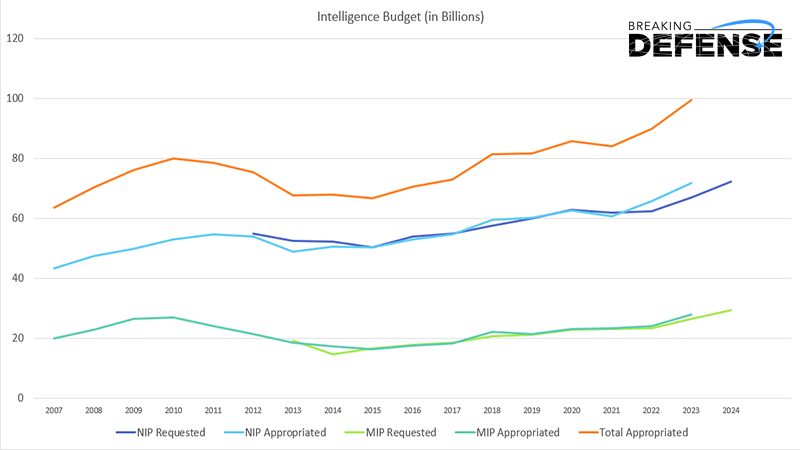
U.S. Navy Seaman Justice Bryan stands watch aboard the aircraft carrier USS George H.W. Bush (CVN 77) in the Persian Gulf Aug. 28, 2014. (U.S. Navy photo by Mass Communication Specialist 3rd Class Brian Stephens/Released)
WASHINGTON — The US budgeted just shy of $100 billion for intelligence-gathering in fiscal 2023, a nearly $10 billion jump over FY22, according to newly released figures from the Director of National Intelligence and the Pentagon.
In separate announcements today, the ODNI revealed Congress had provided $71.7 billion for the National Intelligence Program (NIP), and the Defense Department said $27.9 billion had been appropriated for the Military Intelligence Program (MIP), totaling $99.6 billion. For FY22, the combined total was $89.8 billion.
The FY23 NIP was over $3 billion more than the ODNI had requested, and the MIP came in $1 billion more than the DoD ask. For FY24, ODNI wants $72.4 billion for the NIP, and DoD wants $29.3 billion for the MIP.
According to past figures released by ODNI, intelligence budget requests and appropriations have been on fairly steady rise since a dip from 2012 to 2015, which ODNI has blamed partly on sequestration.

The requested and appropriated National Intelligence Program and Military Intelligence Program budgets since 2007, based on ODNI figures. (Breaking Defense)
Beyond that, details for both programs are scarce as the intelligence chief is not obligated to make any figures beyond the topline public and, according to a 2022 congressional report [PDF], no statute requires the disclosure of the MIP at all, though it’s routinely been done since 2010.
The NIP, overseen by the ODNI, is dedicated to gathering strategic intelligence for policymakers and covers the CIA, NSA and other broad-strokes intelligence-gathering organizations, including military organizations like the National Geospatial-Intelligence Agency, according to a January congressional report [PDF]. The NIP also funds some of the most closely held operations, Sensitive Compartmented Information programs, “throughout the intelligence community.”
The MIP, by contrast, is overseen by the Pentagon and “funds defense intelligence activities intended to support operational and tactical level intelligence priorities supporting defense operations.” (The IC’s 18 members include nine DoD “components,” including intelligence arms of each service, and nine non-DoD components, like the CIA, DEA, FBI and the intelligence unit of the Treasury.)
But the congressional report notes that the NIP and MIP do not make up the total of US spending on intelligence, and don’t account for some “intelligence-gathering entities that support a department-specific mission [and] use department funds” in the sprawling national security community. Nor does the MIP cover certain platforms involved in intelligence, like some drone programs, if intelligence-gathering is not the system’s primary activity.






















